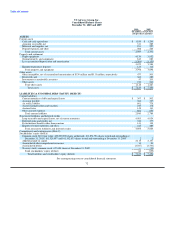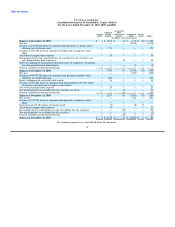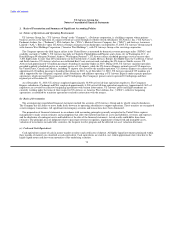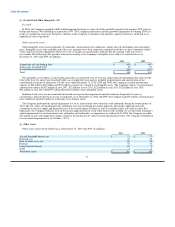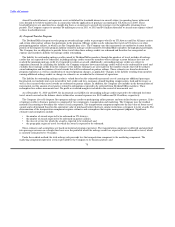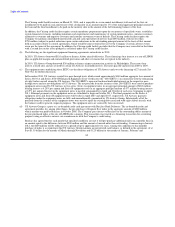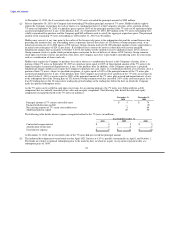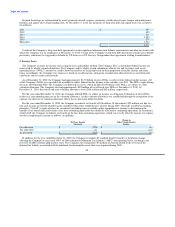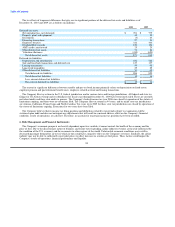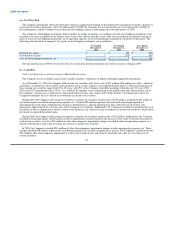US Airways 2010 Annual Report Download - page 82
Download and view the complete annual report
Please find page 82 of the 2010 US Airways annual report below. You can navigate through the pages in the report by either clicking on the pages listed below, or by using the keyword search tool below to find specific information within the annual report.
Table of Contents
(s) Express Expenses
Expenses associated with the Company's wholly owned regional airlines and affiliate regional airlines operating as US Airways
Express are classified as Express expenses on the consolidated statements of operations. Express expenses consist of the following (in
millions):
Year Ended Year Ended Year Ended
December 31, December 31, December 31,
2010 2009 2008
Aircraft fuel and related taxes $ 769 $ 609 $ 1,137
Salaries and related costs 257 246 244
Capacity purchases 1,065 1,059 1,049
Aircraft rent 51 51 51
Aircraft maintenance 89 81 74
Other rent and landing fees 129 121 115
Selling expenses 173 154 163
Special items, net (a) (1) 3 —
Depreciation and amortization 25 25 25
Other expenses 172 170 191
Express expenses $ 2,729 $ 2,519 $ 3,049
(a) In 2010, the Company recorded a $1 million refund for its Express subsidiaries of ASIF previously paid to the Transportation
Security Administration ("TSA") during the years 2005 to 2009.
In 2009, the Company recorded a $3 million write down related to certain Express spare parts inventory to reflect lower of cost or
market value.
(t) Recent Accounting Pronouncements
In December 2009, the Financial Accounting Standards Board ("FASB") issued ASU No. 2009-17, "Consolidations (Topic 810) –
Improvements to Financial Reporting by Enterprises Involved with Variable Interest Entities." ASU No. 2009-17 changes how a
reporting entity determines when an entity that is insufficiently capitalized or is not controlled through voting (or similar rights) should be
consolidated. The determination of whether a reporting entity is required to consolidate another entity is based on, among other things,
the other entity's purpose and design and the reporting entity's ability to direct the activities of the other entity that most significantly
impact the other entity's economic performance. ASU No. 2009-17 requires a reporting entity to provide additional disclosures about its
involvement with variable interest entities and any significant changes in risk exposure due to that involvement. A reporting entity is
required to disclose how its involvement with a variable interest entity affects the reporting entity's financial statements. ASU
No. 2009-17 is effective for fiscal years beginning after November 15, 2009, and interim periods within those fiscal years. The Company
adopted ASU No. 2009-17 as of January 1, 2010, and its application had no impact on the Company's consolidated financial statements.
In October 2009, the FASB issued ASU No. 2009-13, "Revenue Recognition (Topic 605) – Multiple-Deliverable Revenue
Arrangements." ASU No. 2009-13 addresses the accounting for multiple-deliverable arrangements to enable vendors to account for
products or services (deliverables) separately rather than as a combined unit. This guidance establishes a selling price hierarchy for
determining the selling price of a deliverable, which is based on: (a) vendor-specific objective evidence; (b) third-party evidence; or
(c) estimates. This guidance also eliminates the residual method of allocation and requires that arrangement consideration be allocated at
the inception of the arrangement to all deliverables using the relative selling price method. In addition, this guidance significantly
expands required disclosures related to a vendor's multiple-deliverable revenue arrangements. ASU No. 2009-13 is effective
prospectively for revenue arrangements entered into or materially modified in fiscal years beginning on or after June 15, 2010 and early
adoption is permitted. A company may elect, but will not be required, to adopt the amendments in ASU No. 2009-13 retrospectively for
all prior periods. The Company's multiple-deliverable revenue arrangements consist principally of sales of frequent flyer program
mileage credits to business partners, which are comprised of two components, transportation and marketing. See Note 1(k) for more
information on the Company's
81



